Looks Like Daylight (7 page)
Read Looks Like Daylight Online
Authors: Deborah Ellis

It was our belief that the love of possessions is a weakness to be overcome. Its appeal is to the material part, and if allowed its way, it will in time disturb the spiritual balance of the man. Therefore the child must early learn the beauty of generosity. He is taught to give what he prizes most, and that he may taste the happiness of giving.
â
Ohiyesa (Charles Alexander Eastman), Wahpeton Santee Sioux
Miranda, 12
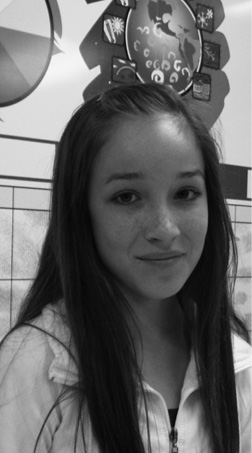
According to a 2011 study by the World Health Organization, the small community of Sarnia, Ontario, has the worst air quality in all of Canada. Just outside the town is Chemical Valley, an area of massive factories that belong to Canada's petrochemical industry.
Directly beside the factories is the First Nations community of Aamjiwnaang. One side of the reserve sits right beside Sarnia. On another side is the St. Clair River, a dividing line between Ontario and Michigan. Chemical Valley makes up the third line of this triangle. A wire fence separates the factories from the reserve's daycare center.
Miranda is the daughter of the Aamjiwnaang First Nation chief. I met her in her school.
I love living on the reserve. It's fun. There are lots of community events. I have friends here.
Dad was elected chief. He likes being chief and takes it seriously. He goes to a lot of meetings. He takes care of things.People bring him their problems and he tries to fix them. He still manages to leave it all at work so that when he comes home he's just a dad. Most of the time.
Mom is a daycare teacher on the reserve. I'd like to do that too. Sometimes I go there to help out. They do special craft workshops I help with, like basketmaking at Easter.
I'm okay at baskets. I'm better at beading.
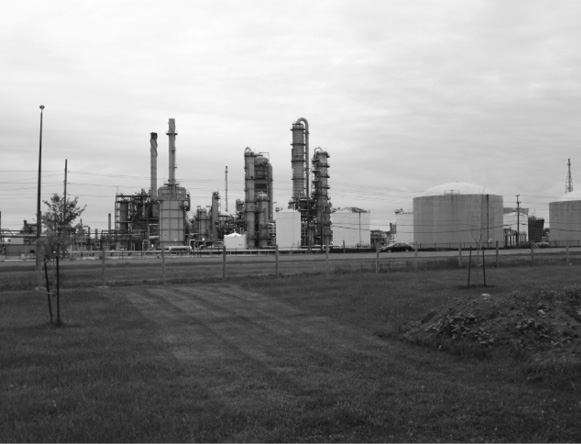
Chemical Valley
The hardest thing about living on this reserve is that there are a whole lot of petrochemical plants right on the edge of our land. DuPont, Shell, Dow. Lots of others.
There's just a regular wire fence separating our land from the factories. We'll see the chemical guys walking around in special protective clothes. And just across the wire the reserve kids are playing in the grass. Sometimes the air is hard to breathe. It hurts my throat. Lots of people have coughs that never go away.
The companies all say it's safe, that there's no pollution, but we can't even go wading in some of our streams now because of all the chemicals.
Sometimes there's a spill from one of the factories and they call Dad. He has to alert everyone to get inside their homes and stay there until it's safe to go outside again.
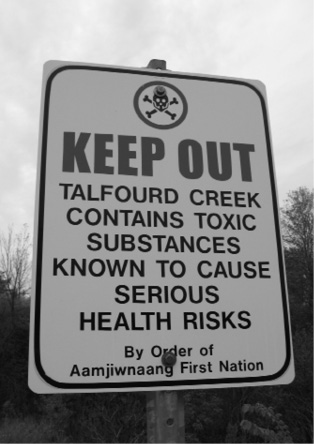
Sign on the edge
of Miranda's reserve
We are surrounded by the factories. I sometimes think they would like it if we all died in a chemical spill. Then they could take over our land and fill it with more factories. Like all those people they killed in India.
There are sirens all over the area that are supposed to go off when there's a spill, but they don't always work. They test them every Monday at 12:30. There's a daycare center and a place for seniors on the reserve right by the factories, and often the sirens there don't work.
One time there was a spill and everyone in Corunna [a small community just south of Sarnia] was evacuated, but not the reserve, even though it's closer.
It's almost a normal thing here to die of cancer, especially if you're a woman. Lots of women here have it, and they don't even have to be old. Even in their thirties they get it. Thirty is old, but it's not really old. Women have a lot of miscarriages too.
We used to swim in the river. There were no warnings posted, so we just did it. We'd come out of the water with big gobs of tar stuck all over us. No wonder the fish and the frogs are all being born with, like, three eyes and weird bodies. We probably all glow in the dark. Fish have tumors and kittens and puppies are born all deformed.
Then there's the pollution from people being idiots. Boats are not allowed to dump their crap into the river, but big private pleasure boats â owned by whites, of course â will come into our territory to dump their waste because they figure it doesn't matter, they won't get caught. My friends and I run down to the dock and yell at them. We shame them and make them go away. It's a bit of a victory, but why do rich people have to be morons?
If I had all the power in the universe I'd take away the chemical plants, make the reserve a bit bigger and have everything clean and good again. My ancestors used to be able to drink from the river. Imagine that! When they got thirsty they could just go down to the river, scoop up some water and drink it.
I would like to be able to do that again.
Our village was healthy and there was no place in the country possessing such advantage, nor no hunting grounds better than those we had in possession. If another prophet had come to our village in those days and told us what has since taken place, none of our people would have believed him.
â
Ma-ka-tai-me-she-kia-kiak, or Black Hawk, Chief of the Sauk and Fox Tribe
Jeremy, 16
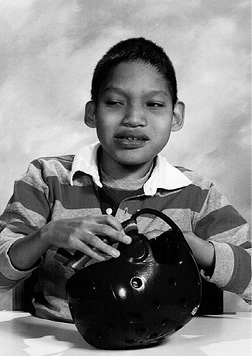
First Nations children with disabilities can face extra challenges, from the remoteness of their communities, the lack of resources available to them, and racism that too often goes hand in hand with the providing of health and social services.
Contrary to the commonly accepted belief that there are way more First Nations children with Fetal Alcohol Spectrum Disorder (brain damage occurring in an unborn baby when a pregnant woman drinks alcohol) than in other communities, some studies say the numbers are the same. What's different is that if a First Nations child has challenges, she is more likely to be labeled with FASD automatically, with other causes such as autism or environmental pollution not even considered or tested for. The wrong diagnosis means the child does not get the proper treatment.
Jeremy is Mi'kmaq and a member of Pictou Landing First Nation in Nova Scotia. His ancestors have been in this territory for more than 9,000 years. There are thirty-five reserves today in Nova Scotia, with a population of about 25,000 people.
I spoke with Jeremy's mother about her son.
Before giving birth to Jeremy, his mother, Maurina, spent five years in Sarnia, in Chemical Valley. She thinks Jeremy may have been affected by all the chemical factories in the area. He was born hydrocephalic, which means there was liquid on his brain. He has since also been diagnosed with cerebral palsy and autism.
When they presented Jeremy to his mother, they told her he probably wasn't going to live long. His mom looked down at him and said, “It's you and me against the world, baby. You and I are gonna work real hard.”
She gave him the best care she could, with special massages and exercises for his eyes. She took him with her everywhere so he wouldn't feel like a stranger in the world. Between hospital stays, he would go to school, where the kids liked him and treated him well.
His first school was mixed, for white and Native kids. Jeremy enjoyed being there. But he would sometimes bang his head â maybe because he was frustrated or because the shunt in his head caused him pain. To try to get him to stop, the staff put him in a small room and turned out the lights. A staff member said Jeremy had been in the room like that for just a few minutes. Kids at the school told Jeremy's mother it had been more like an hour.
The Pictou Landing First Nation told Jeremy's mother she could bring him there. And she did.
For many years workers came to her home to help her with Jeremy. Jeremy needs a lot of care, as there are many things he can't do on his own. He gets high fevers and at times he starts gagging and can't get himself to stop. He gets pneumonia easily and often.
A little while ago his mother had a stroke. It has become very hard for her to look after Jeremy. And the money that Pictou Landing First Nation has to hire helpers is running out. His mother doesn't know what to do.
The federal government told her that if she took him off the reserve and put him in an institution, they would pay for his care. But there was no separate funding for children with disabilities who live on reserves.
His mother doesn't want to put him in an institution. On the reserve he has friends, people talk to him. One friend comes over and tells him, “Get your shoes, it's time for a cruise!” And Jeremy laughs and gets excited. If he's put into an institution, his mother is afraid he'll become a lonely guy, lost inside himself.
Then his mother discovered Jordan's Principle, named after Jordan River Anderson of the Norway House Cree Nation. Jordan spent the entire four years of his life in the hospital while different levels of government argued about who would pay for him to be cared for at his home. The principle declares that the needs of a First Nations child should be met first, and any intergovernmental squabbling about payment should happen after.
Now she has another way to fight.
“Jeremy is a wonderful little man,” she says. “He loves to go to the beach. He doesn't swim, but he can walk around in the water. Water is heavy and it makes his legs stronger. He likes watching the PBS station on TV, and he likes listening to music. He can use his feet like they are a second pair of hands. He's a wonderful son. When people take the time to know him, they always like him.”
Larry, 18
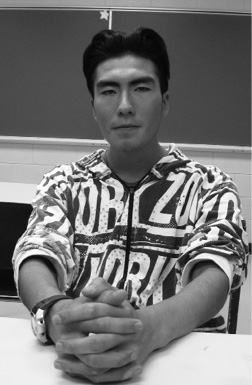
For many years, silence surrounded residential school survivors. The people who had committed unspeakable crimes against these children went on with their lives and careers, not having to account for what they had done. The governments and institutions that had formulated the policies to create and manage the residential school system went on to create new policies. They did not look back at the destruction they had caused until the survivors, with great courage, started speaking out and demanding better.
In Canada, the Truth and Reconciliation Commission was established to provide a forum for survivors of residential schools to tell their stories as well as have them recorded and acknowledged. Communities are using traditional ceremonies to help survivors and their descendants heal from the experience. Mohawk women of the Six Nations use traditional grieving rituals with songs and prayers to help release people from the trauma they have been through. The Weeneebayko Area Health Authority assists communities in the James Bay area of northern Ontario through traditional Cree ceremonies like shaking tents. The Aboriginal Healing Foundation, whose funding was discontinued by the federal government in 2010, provided assistance to many communities seeking to heal from what happened to them.
Religious institutions and governments have paid compensation to the victims of abuse at their schools. The Canadian prime minister gave an official apology in 2008, and residential school survivors are paid tribute to in a stained-glass window at the House of Commons.
The silence and shame that surrounded this experience have started to be lifted, and people are reclaiming their heritage and their pride.
Larry lives in South Indian Lake in northern Manitoba. He is about to graduate from high school.
Mom and Dad both got to grade nine. My dad works for hydro now. My mom died of alcohol poisoning a couple of years ago. I think she had her share of problems when she was young. She tried her best to keep us happy. She made sure we had clothes, made sure we ate. She was a really good mom. I miss her a lot. She taught me how to be a good person.
My parents were always fighting. They were on the verge of separating when she died.
I have five brothers and five sisters. I'm the second youngest. My older brother Lorne killed himself in 2007. We grew up seeing drugs and alcohol around all the time. Mom would try to hide it all from us and keep it quiet, but kids always know what's going on. I looked after my younger brother. The older kids looked after the both of us.
My grandparents are residential school survivors. My grandpa lasted until grade ten. He sometimes talks about it. The terrible ways they got disciplined. He had to put his hand flat on his desk and leave it there while the teacher hit him over and over with a ruler. If he pulled his hand back, he got hit more.
South Indian Lake is a nine-hour bus ride from this school. I go home only for Christmas and spring break unless the weather is too bad. I'm at school most of the year.
South Indian Lake is small. It's a Cree community. Some of the elders still speak Cree fluently, which is a miracle when you think of everything that happened to them at the residential school. There's moose, caribou, bears, some houses, a school, a fire hall, a Northern store, a health complex. There used to be a pool hall, but it burned down.
There are a lot of traditional practices in the community. One of them is youth drumming practice. I've gone with my cousins. You learn to play with a good rhythm and to do the proper preparation before you play. You smudge with sweetgrass to cleanse, then you present an offering of tobacco to honor the drum. We drum at community gatherings and events like Treaty Days and Games Days. It makes me feel proud to be learning something that's been passed down for generations.
My Uncle Frank is trying to get someone to teach Hoop dancing. It would be pretty awesome to see some kids from our community doing Hoop dancing.
Our community used to be on one side of the lake but then a dam was built and the community was flooded out and got moved to higher ground. People's memories were washed away. The water used to be clear. Now it's all muddy. It used to be healthy with fish, but there are hardly any fish now. My people got had.
The homes in the community are very crowded. In my house there are twelve people â me, my brother, my sister Thelma, Thelma's boyfriend, my sister Dorothy, Thelma's kids Josh Jr., Kathy, Lorne, Jermine, Dorothy's kids Shawn and Wayne, and my friend Marty, whose parents drink so he came to see if he could stay with us. It's a small house. People sleep everywhere.
So many of us are in there, but it makes it easy to watch the kids. There's always someone around to keep an eye on them. It all somehow works out.
When I was eleven I was taken away by Child and Family Services. They put me in a foster home in Thompson. I was there for a year and a half. The people were nice to me but I was missing home so much. For the longest time I didn't talk at all or watch TV or eat hardly anything. I stayed in bed for a long time with the covers over my head. My sister was in the same foster home. She kept telling me everything was going to be all right, that Mom would come and get us.
Then we went back to our parents. They'd drink after we went to bed. We'd get up early and clean the house before we went to school. You could smell the booze in the air.
Dad still drinks large amounts of alcohol whenever he gets the chance. He's had two minor strokes and his heart is weak. I ask him to stop but â¦
He goes out to Nelson House for work. He's gone for months, comes back for a bit, then goes off again.
I try to be a good person. Sometimes I have turned to drugs and alcohol. Then I would see this chain. My grandparents drank and my parents drank and all this pain is like a chain around our community. Sometimes I find it hard to walk around my community without running into a drunk. I ask them, “Why are you hurting yourself?” They say, “I want to forget.” I try to tell them alcohol isn't the answer.
It's supposed to be a dry community, but bootleggers smuggle it in. It's very frustrating. I try to keep it out of my house. I look after my nieces and nephews and keep the house clean.
There are big problems, but small bits of light can help. The people in South Indian Lake are good people. Even with all the pain they try to be there for each other. I'm proud to be a part of them.
I've been to Winnipeg a couple of times. It may have everything but it doesn't have that feeling of earth. Everything is covered in concrete.
I wish I'd lived five hundred years ago, back when there was no arrival of white men. I think it would be easier. Just hunt and fish to provide for your family and live. And I'd be speaking my own language, which I'm still trying to do.
I guess I'm hopeful though. I don't want my kids growing up seeing me drunk and covered in mud. I've thought about it for a very long time, whether I can make a difference so that none of this alcohol or drugs will be here. It's a sickness and I'm just wanting to try to get it away. A lot of people feel the way I do.
Human beings are all the same. White people have their share of problems too.
